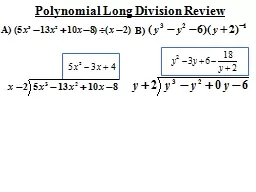

A B SYNTHETIC DIVISION STEP 1 Write the Polynomial in DESCENDING ORDER by degree and write any ZERO coefficients for missing degree terms in order STEP 2 Solve the Binomial Divisor Zero ID: 418504
Download Presentation The PPT/PDF document "Polynomial Long Division Review" is the property of its rightful owner. Permission is granted to download and print the materials on this web site for personal, non-commercial use only, and to display it on your personal computer provided you do not modify the materials and that you retain all copyright notices contained in the materials. By downloading content from our website, you accept the terms of this agreement.
Slide1
Polynomial Long Division Review
A)
B)Slide2
SYNTHETIC DIVISION:
STEP #1
:
Write the Polynomial in DESCENDING ORDER by degree and write any ZERO coefficients for missing degree terms in order
STEP #2
:
Solve the Binomial Divisor = Zero
STEP #3
:
Write the ZERO-value, then all the COEFFICIENTS of Polynomial.
Zero = 2
5 -13 10 -8 = Coefficients
STEP #4 (Repeat)
:
(1) ADD Down, (2) MULTIPLY, (3) Product
Next ColumnSlide3
SYNTHETIC DIVISION:
Continued
STEP #5
:
Last Answer is your REMAINDER
STEP #6
: POLYNOMIAL DIVISION QUOTIENT
Write the coefficient “answers” in descending order starting with a Degree ONE LESS THAN Original Degree and include NONZERO REMAINDER OVER DIVISOR at end
(If zero is fraction, then divide coefficients by denominator)
Zero = 2
5 -13 10 -8 = Coefficients
5
10
-3
-6
4
8
0 = Remainder
5 -3 4
SAME ANSWER AS LONG DIVISION!!!!Slide4
SYNTHETIC DIVISION:
Practice
Zero =
= Coefficients
[1]
[2]
[3]
[4]
Divide by 2Slide5
REMAINDER THEOREM
:
Given a polynomial function f(
x
): then f(a) equals the remainder of
Example
: Find the given value
2 1 3 - 4 -7
2 10 12
1 5 6 5
Method #1:
Synthetic Division
Method #2:
Substitution/ Evaluate
[A]
[B]
-3 1 0 - 5 8 -3
-3 9 -12 12
1 -3 4 -4 9Slide6
FACTOR THEOREM
:
(
x
– a) is a factor of f(
x) iff f(
a
) = 0 remainder = 0
Example
: Factor a Polynomial with Factor Theorem
Given a polynomial and one of its factors, find the remaining factors using synthetic division.
(Synthetic Division)
-3 1 3 -36 -108
-3 0 108
1 0 -36 0
(x + 6) (x - 6)
Remaining factorsSlide7
Given a polynomial and one of its factors, find the remaining factors.
STOP once you have a quadratic!
PRACTICE
: Factor a Polynomial with Factor Theorem
[A]
STOP once you have a quadratic!
[B]Slide8
Finding EXACT ZEROS (ROOTS) of a Polynomial
[1]
FACTOR
when possible & Identify zeros:
Set each Factor Equal to Zero
[2a]
All Rational Zeros
= P = leading coefficient, Q = Constant of polynomial
[2b]
Use SYNTHETIC DIVISION
(
repeat until you have a quadratic
)
[3]
Identify the remaining zeros
Solve the quadratic = 0
(1) factor (2) quad formula (3) complete the square
Answers must be exact, so factoring and graphing won’t always work!Slide9
Example 1
:
Find ZEROS/ROOTS of a Polynomial by FACTORING:
(1) Factor by Grouping
(2) U-Substitution
(3) Difference of Squares, Difference of Cubes, Sum of Cubes
[A]
[B]
Factor by Grouping
Factor by Grouping
[C]
[D] Slide10
Example 2
:
Find ZEROS/ROOTS of a Polynomial by SYNTHETIC DIVISION (
Non-Calculator)
Find all values of
Check each value by synthetic division
[A]
[B]
Possible Zeros (P/Q)
±1, ±3, ±7, ±21
Possible Zeros (P/Q)
±1, ±2Slide11
Example 2
:
PRACTICE
[C]
[D]
Possible Zeros (P/Q)
±1, ±3
Possible Zeros (P/Q)
±1, ±2, ±4, ±8Slide12
Example 2
:
PRACTICE
[E]
[F]
Possible Zeros (P/Q)
±1, ±2, ±3, ±6, ±
1
/
2
, ±
3
/
2
Possible Zeros (P/Q)
±1, ±2, ±4, ±
1
/
2
Slide13
Example 2
:
PRACTICE
[G]
[H]
Possible Zeros (P/Q)
±1, ±2, ±3, ±6, ±
1
/
3
, ±
2
/
3
Possible Zeros (P/Q)
±1, ±2, ±
1
/
2
±
1
/
3
, ±
2
/
3 ,
±
1
/
6Slide14
Example 3
:
Find ZEROS/ROOTS of a Polynomial by GRAPHING (Calculator)
[Y=],
Y
1
= Polynomial Function and Y
2
= 0
[2
ND
]
[TRACE: CALC]
[5:INTERSECT]
First Curve?
[
ENTER],
Second Curve?
[ENTER]
Guess?
Move to a zero
[ENTER]
[A] Slide15
[B]
Example 3
:
PRACTICESlide16
[C]
Example 3
:
PRACTICE